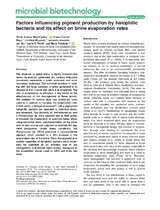Factors influencing pigment production by halophilic bacteria and its effect on brine evaporation rates
Date
2018Author
Silva-Castro, Gloria Andrea
Moyo, Anesu Conrad
Khumalo, Londiwe
van Zyl, Leonardo Joaquim
Petrik, Leslie F.
Trindade, Marla
Metadata
Show full item recordAbstract
The disposal of reject brine, a highly concentrated
waste by-product generated by various industrial
processes, represents a major economic and environmental
challenge. The common practice in dealing
with the large amounts of brine generated is to
dispose of it in a pond and allow it to evaporate. The
rate of evaporation is therefore a key factor in the
effectiveness of the management of these ponds.
The addition of various dyes has previously been
used as a method to increase the evaporation rate.
In this study, a biological approach, using pigmented
halophilic bacteria (as opposed to chemical dyes),
was assessed. Two bacteria, an Arthrobacter sp. and
a Planococcus sp. were selected due to their ability
to increase the evaporation of synthetic brine. When
using industrial brine, supplementation of the brine
with an iron source was required to maintain the pigment
production. Under these conditions, the
Planococcus sp. CP5-4 produced a carotenoid-like
pigment, which resulted in a 20% increase in the
evaporation rate of the brine. Thus, the pigment production
capability of halophilic bacteria could potentially
be exploited as an effective step in the
management of industrial reject brines, analogous to
the crystallizer ponds used to mine salt from sea
water.

